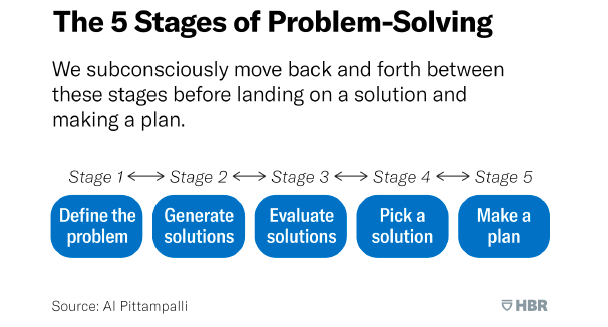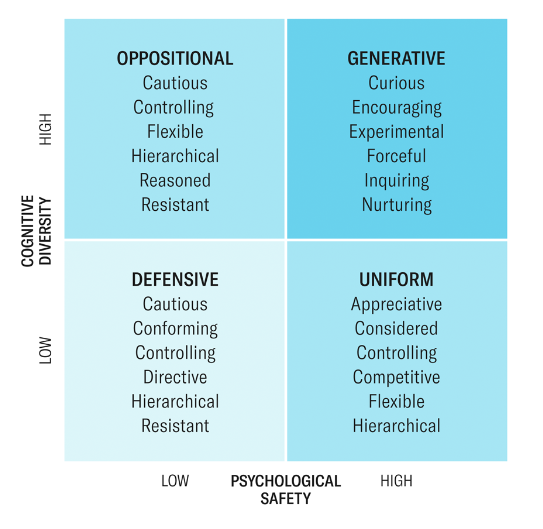
Approaches to Solving Problems in the Workplace
27 April 2022 4 min Read

This is a recap of Harvard Business Review’s @HarvardBiz How to Solve Problems by Laura Amico @HiLauraAmico.
“You’d think that many brains working together would mean better solutions, but the reality is that too often problem-solving teams fall victim to inefficiency, conflict, and cautious conclusions.”
Laura Amico @HiLauraAmico
Watch this video recap, or read the full article below.
MORE KNOWLEDGE | LESS TIME
The Two Minute Takeaway
KEY TAKEAWAY 1
Approaches to solving problems: there are 5 stages to problem-solving according to this research:

Source, HBR: Why Groups Struggle to Solve Problems Together
KEY TAKEAWAY 2
There’s another batch of research (here) also from HBR regarding the top traits of the best problem-solving teams in workplaces. This research states that highly effective teams that solve problems the right way has a pair of common features: the teams are cognitively diverse and psychologically safe (to note, these are two of the core fundamentals as to what Swae brings to the table!).

Source, HBR
What’s essential to understand is that it’s best to fully map out the problem-solving approach that you’re taking. This will make sure you consistently use everyone’s time wisely (including your own) and allow you to come back to the “what works” time and time again. From this place, you can iterate off of that list, and continuously build the go-to document for your group’s problem-solving best practices (becoming a template to make this process much easier).
Some common approaches to building your group problem-solving best practices list:
- Think about the last problem you had to solve as a team and map out what you remember about each step you’ve used in the problem-solving process.
- Answer these questions after each group problem-solving session: Were you all on the same page at each stage? If not, why? How could you ensure people are in sync as you move through each phase of the problem-solving process? What would you do differently? Take copious notes to ensure you’re tracking against these things so you can make sure you do better each time.
- Take the chart above (how to solve problems) and ask each person where they felt that they ranked. Log what behaviors could be adopted across the group that would help more and more people move into the top-right quadrant.
Why This Matters
Leadership and managers in companies across the board can solve problems faster with groups that have more cognitive diversity (as you gain a lot more perspective), and the engagement and outcomes are far better in environments where people feel psychologically safe to voice their opinions, thoughts and provide ideas/solutions.
Toxic cultures permeate many corporate workplaces where people don’t feel safe speaking up and this has a negative effect on the entire culture and the way people operate day to day. (You can see more on this subject in this research recap here.)
Solving problems is a vital part of any role, even in junior positions, because one person’s decision can affect the entire whole in any workplace (regardless of size or business category). All it takes is one person to make one really bad decision, right?!
Summary and Next Steps
Read the full HBR Article
Join our community and get the inside scoop, the latest insights to hack your innovation and helpful tips from our gurus.
This recap references the Harvard Business Review article How to Solve Problems
https://hbr.org/2019/11/why-groups-struggle-to-solve-problems-together
by Laura Amico @HiLauraAmico.

Swae is helping organizations across the world to solve today’s problems and create tomorrow’s strategy. From Start-ups to Charities, and Enterprises to DAOs, our clients find that their greatest resource is their people, and Swae is proven to help get the best from the untapped potential within their workforce.
We’d love the chance to show you how Swae can help you find your next winning ideas…

Ready to learn how Swae can help your organization?
More to explore…
How to be seen as a Brilliant and Bold Leader [Become a great Communicator]
How to be seen as a Brilliant and Bold Leader [Become a great Communicator] 1 June 2022 4 min ReadThis is a recap of Harvard Business Review @HarvardBiz ’s Good Leadership is About Communicating Why, by Nancy Duarte @nancyduarte. Becoming a bold leader means that...
Being Honest in Leadership Roles Helps Drive Innovation and Long-Term Success
Being honest in Leadership roles helps drive Innovation and long-term Success Doing Decision-Making Right Without Blinders On23 May 2022 5 min ReadThis is a recap of Harvard Business Review’s @HarvardBiz “Decisions Without Blinders” study. Being honest in leadership...
Many Companies Are Hiring Immediately [Research Shows People Desire Better Workplaces]
Many Companies Are Hiring Immediately [Research Shows People Desire Better Workplaces] Workers Are Quitting Their Jobs Like Never Before 15 May 2022 4 min ReadMany companies are hiring immediately and there’s a big reason why. U.S. workers are quitting their jobs like...

![How to be seen as a Brilliant and Bold Leader [Become a great Communicator]](https://swae.io/wp-content/uploads/Resources_Swae_Harvard_Business_review_How-to-Be-Seen-as-a-Brilliant-and-Bold-Leader-Become-a-Great-Communicator-400x250.png)

![Many Companies Are Hiring Immediately [Research Shows People Desire Better Workplaces]](https://swae.io/wp-content/uploads/Rew_Research_Swae_Many-Companies-Are-Hiring-Immediately-Research-Shows-People-Desire-Better-Workplaces-1-400x250.png)
Your point of view caught my eye and was very interesting. Thanks. I have a question for you.
Can you be more specific about the content of your article? After reading it, I still have some doubts. Hope you can help me.
Thanks for sharing. I read many of your blog posts, cool, your blog is very good.
The point of view of your article has taught me a lot, and I already know how to improve the paper on gate.oi, thank you. https://www.gate.io/th/signup/XwNAU
I don’t think the title of your article matches the content lol. Just kidding, mainly because I had some doubts after reading the article. https://www.binance.com/de-CH/register?ref=PORL8W0Z
I don’t think the title of your article matches the content lol. Just kidding, mainly because I had some doubts after reading the article. https://accounts.binance.com/de-CH/register?ref=RQUR4BEO
Can you be more specific about the content of your article? After reading it, I still have some doubts. Hope you can help me. https://accounts.binance.com/es/register?ref=WTOZ531Y
I don’t think the title of your article matches the content lol. Just kidding, mainly because I had some doubts after reading the article. https://www.binance.com/ru-UA/join?ref=B4EPR6J0
Can you be more specific about the content of your article? After reading it, I still have some doubts. Hope you can help me. https://www.binance.com/cs/register?ref=V2H9AFPY
I don’t think the title of your article matches the content lol. Just kidding, mainly because I had some doubts after reading the article.
Your point of view caught my eye and was very interesting. Thanks. I have a question for you.
Your point of view caught my eye and was very interesting. Thanks. I have a question for you.